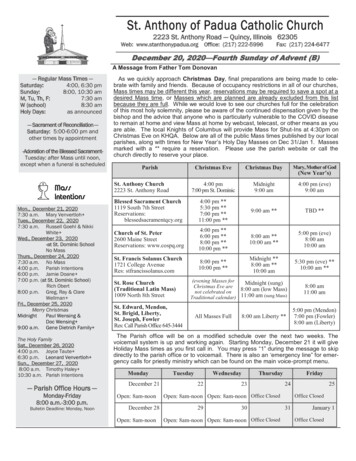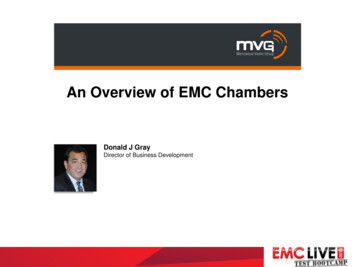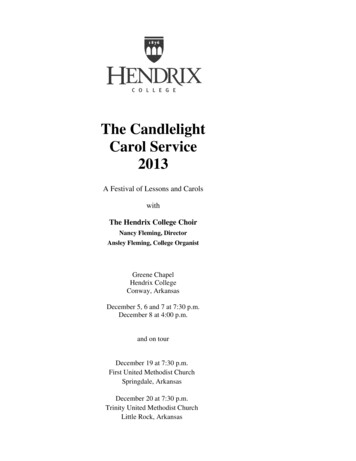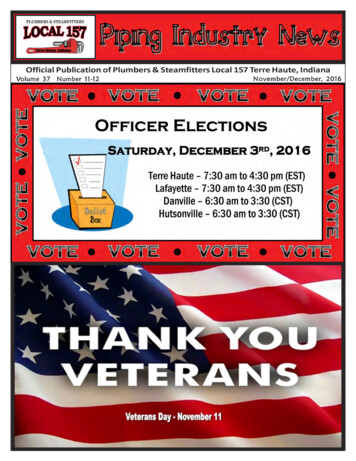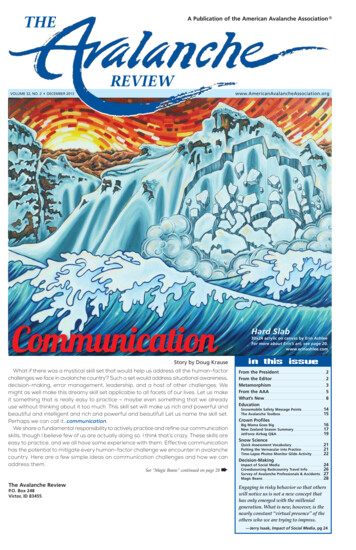
Transcription
Volume 32, No. 2 December 2013Hard Slab30x24 acrylic on canvas by Erin AshleeFor more about Erin’s art, see page 20.www.erinashlee.comStory by Doug KrauseWhat if there was a mystical skill set that would help us address all the human-factorchallenges we face in avalanche country? Such a set would address situational awareness,decision-making, error management, leadership, and a host of other challenges. Wemight as well make this dreamy skill set applicable to all facets of our lives. Let us makeit something that is really easy to practice – maybe even something that we alreadyuse without thinking about it too much. This skill set will make us rich and powerful andbeautiful and intelligent and rich and powerful and beautiful! Let us name the skill set.Perhaps we can call it communication.We share a fundamental responsibility to actively practice and refine our communicationskills, though I believe few of us are actually doing so. I think that’s crazy. These skills areeasy to practice, and we all have some experience with them. Effective communicationhas the potential to mitigate every human-factor challenge we encounter in avalanchecountry. Here are a few simple ideas on communication challenges and how we canaddress them.See “Magic Beans” continued on page 28 In This IssueFrom the PresidentFrom the EditorMetamorphismFrom the AAAWhat’s NewEducation. . . . . . . . . . . . . . . . . . . . . . . . . . . . . . . . . . . . . . . . . . . . . . . . . . . . . . . . . . . . . . . . . . . . . . . . . . . . . . . . . . . . . . . . . . . . . . . . . . . . . . . . . . . . . . . . . . . . . . . . . . . . . . . . . . . . . . . . . . . . . . . . . . . . . . . . . . . . . . . . . . . . . . . . . . . . . . . . . . . . . . . . . . . . . . . . . . . . . . . . . . . . . . . . . . . . . . . . . . . . . . . . . . . . . . . . . . . . . . . . . . . . . . . . . . . . . . . . . . . . . . . . . . . . . . . . . . . . . . . . . .Snowmobile Safety Message PointsThe Avalanche Toolbox. . . . . . . . . . . . . . . . . . . . . . . . . . . . . . . . . . . . . . . . . . . . . . . . . . . . . . . . . . . . . . . . . . . . . . . . . . . . . . . . . . . . .Crown ProfilesBig Mama Goes BigNew Zealand Season SummaryJetForce Airbag Q&A. . . . . . . . . . . . . . . . . . . . . . . . . . . . . . . . . . . . . . . . . . . . . . . . . . . . . . . . . . . . . . . . . . . . . . . . . . . . . . . . . . . . . . . . . . . . . . . . . . . . . . . . . . . . . . . . . . . . . . . . . . . . . .Snow ScienceQuick Assessment VocabularyPutting the Vernacular into PracticeTime-Lapse Photos Monitor Glide Activity. . . . . . . . . . . . . . . . . . . . . . . . . . . . . . . . . . . . . . . . . . . . . . . . . . . . . . . . . . . . . . . . . . . . . . . . . . . . . . . . . . . .Decision-MakingImpact of Social MediaCrowdsourcing Backcountry Travel InfoSurvey of Avalanche Professionals & AccidentsMagic Beans. . . . . . . . . . . . . . . . . . . . . . . . . . . . . . . . . . . . . . . . . . . . . . . . . . . . . . . . . . . . . . . . . . . . . . . . . . . . . . . . . . . . . . . . . . . . . . . . . . . . . . . . . . . . . . . . . . . . . . . . . . . . . . . . . . . . . . . . . . . . . . . . . . . . . . . . . . . . . . . . .The Avalanche ReviewP.O. Box 248Victor, ID 8345522358141516171921212224262728Engaging in risky behavior so that otherswill notice us is not a new concept thathas only emerged with the millenialgeneration. What is new, however, is thenearly constant “virtual presence” of theothers who we are trying to impress.—Jerry Isaak, Impact of Social Media, pg 24
u PAGE 2the avalanche reviewTHEVol. 32, No. 2, December 2013from the presidentWelcome President Stimbuck!REVIEWDecember 2013 VOL. 32 NUMBER 2The Avalanche Review is published each fall through spring bythe American Avalanche Association, Inc., a nonprofit corporation.The Avalanche Review welcomes the submission of articles,photographs and illustrations.Please send submissions to:Lynne Wolfe –– EditorPO Box 1135Driggs, Idaho 83422tel: (208) g:Paul Nordquist1101 Lenore DriveTacoma, WA 98406tel: (253) 830-4444pwnordquist@gmail.comProduction:Fall Line Design270 N MainDriggs, ID 83422tel/fax: (208) 354-6500karen@FallLineDesign.comBusiness and Subscription Office:Jaime Musnicki –– AAA Executive DirectorPO Box 248Victor, ID 83455tel: (307) tive Director.Jaime MusnickiAAA Officers*President.John Stimberis*Vice President.Bill Williamson*Secretary.Scott Savage*Treasurer.Mike FerrariCommittee ChairsAwards.Halsted MorrisData & IT/Web.Ned BairEducation.Kirk BachmanEthics.Aleph Johnston-Bloom, Dave HendricksonMembership.Stuart ThompsonResearch.Jordy HendrikxSearch & Rescue.Rich BrowneSki Area.Bill Williamson*Publications.Blase ReardonPublications CommitteeEditor.Lynne WolfeEditor Emeritus.Steve CongerEditor Emeritus.Sue FergusonEditor Emeritus.Blase ReardonEditor Emeritus.Bruce TremperHello fellow American Avalanche Association members,John Stimberis from the Pacific Northwest here! You probably readabout our new executive director in the last issue of The Avalanche Review(TAR 32-1). I’d like to take the opportunity to tell you about some otherthings that are happening with the American Avalanche Association. Lifeis often demanding, and we just can’t give as much as we would like.We have a couple of changes within the governing board and executivecommittee. Lel Tone has stepped down as ethics chair; welcome to newAlaska-based co-chairs Aleph Johnston-Bloom and Dave Hendrickson.Lel has done a great job during her tenure on the board, and we willmiss her. Dale Atkins, our president for the past few years, has steppeddown as well. Our governing board elected me to fill his position, andthus I have stepped up from the role of vice president. Bill Williamson,former ski-area representative to the AAA board, has been elected tofill the position of vice president.Many of you likely know Bill, but may not be as familiar with me.I’ve been in the avalanche industry for over 20 years, beginning mycareer as a pro patroller at Alpental ski area in Washington state. I stillpatrol part time, and my full-time job is running the avalanche forecastand control program for WSDOT on Snoqualmie, White, and ChinookPasses. This winter starts my fifteenth forecast season with WSDOT. Inaddition to these jobs I also teach avalanche courses and stay involvedwith snow-related research. When I’m not on the snow I’m usually trying Roland Emetaz, aka Mr Em, sent TAR a couple ofto find some live music, or more recently getting the hang of a new life in candid portraits from ISSW 2013. John Stimberis,Seattle. Right now I am very excited to take on the role of AAA president top, replaces Dale Atkins, below, as AAA president.Thank you Dale and welcome Stimbuck!and work with these incredible men and women who provide so muchenergy to our organization. I welcome your input, so feel free to contact me at aaa.stimberis@outlook.comIn addition to the board changes, we have hired Dallas Glass to coordinate the AVPro course. AVPro is scheduledto take place at Lake Tahoe this winter. We will see some other changes arriving soon. One of the biggest andmost visible will be the changes to avalanche.org. These involve a Google-based map that will display themany forecast regions in the US along with the current hazard rating for each. The education committee andcertified instructor program will be unveiling continuing professional development requirements for certifiedinstructors. They are also working through guidelines related to the professional and recreational educationtracks. The governing board was busy at the fall meeting; watch for the minutes in the next issue of TAR. I’mrunning out of space, but I’ll leave you with this: The one thing that will not change is the high quality of TheAvalanche Review. Read on and enjoy!—John Stimberis, AAA president Rfrom the editorSection RepresentativesAlaska.Andy DietrickEastern Section.Kyle TylerEuropean Section.Krister KristensenIntermountain North.Mark StaplesIntermountain South.Damian JacksonNorthwest.Patty MorrisonRockies.Becs HodgettsSierra.Gene UrieMember Representative.Jonathan ShefftzCertified Instructor Rep.Brad SawtellExecutive Committee denoted by *The mission of the AAA is:A. To provide information about snow and avalanches;B. To represent the professional interests of the United Statesavalanche community;C. To contribute toward high standards of professional competenceand ethics for persons engaged in avalanche activities;D. To exchange technical information and maintain communicationsamong persons engaged in avalanche activities;E. To provide direction for, promote, and support avalanche educationin the US;F. To promote research and development in avalanche safety.Subscription: 30 per year (4 issues). Subscription is included with membership dues to AAA. For subscription and membership information, ons: Please submit material eight weeks prior to publicationdate. Include address and telephone number. Please submit typed manuscripts by e-mail or disk (CD or DVD), using any popular word processingprogram. Submit any figures as an EPS (preferred), PDF, TIFF or JPG file(300 dpi resolution at 100%). We will return materials if you include astamped, self-addressed envelope.Articles, including editorials, appearing in The Avalanche Review reflectthe individual views of the authors and not the official points of viewadopted by AAA or the organizations with which the authors are affiliatedunless otherwise stated.Layout & Design: Karen Russell, Fall Line Design, (208) 354-6500,karen@FallLineDesign.com. 2013 by the American Avalanche Association.Materials may be reproduced for research or classroom use.Permission is also granted for use of short quotations, figures, andtables in scientific books and journals. For permission for otheruses, contact The Avalanche Review.TAR editor Lynne Wolfe and Exum chief guide Bill Anderson sharea story from TAR 31-4.Food for ThoughtTAR 32-2 brings you a buffet of food for thought forthe holidays. We couldn’t resist putting Doug Krause’sentertaining and enlightening essay on communicationon the cover; his humor and insight bring home somecrucial messages. We also want to showcase young artistErin Ashlee’s paintings in this issue, the cover, Hard Slab,is colorful and White Dragon on page 20 is haunting.Further in this issue, we have a number of decisionmaking and communication-focused essays. In particular,Jerry Isaak and Bruce Tremper’s discussions of socialmedia and its implications will require us as educators toexamine our approach to teaching decision-making to themillenial generation. Jordy Hendrikx uses state-of-the-artGPS tracking to investigate the intersections of terrain,avalanche forecasts, and decision-making. Find out howto use your phone to add to his data set on page 26.Jerry Johnson and Scott Savage further their researchinto workplace accidents on page 27, then proceed toeducate us about Atul Gawande and his work on thevalue of checklists, the apparent buzzword for this earlywinter. Look for more information in future issues of TARabout pre-tour checklists in place in the workplace, morespecifically at the CAIC and throughout the NationalAvalanche Center forecast centers.Then we have some traditional avalanche tales andphotos from the Southern Hemisphere, brought to usby our perennial New Zealand correspondents BradCarpenter and Jason Konigsberg. Photographer IreneHenninger had good placement and timing for an amazingphoto of Big Mama and her powder cloud, showcased inthe centerfold on page 16.Don’t overlook Andy Gleason’s tight little essay on thepower of the avalanche toolbox on page 15. He makesa strong case for the power of perfect practice, not justunderstanding the concepts of hazard assessment.In the snow science column, Ron Simenhois continuesto try to understand the glide crack phenomenon; timelapse photography helps him keep a constant eye on theirmovements. TAR was able to persuade Kim Grant andJessica Baker of ARG to share their work with the late TheoMeiners on quick snow testing, bringing us theory andpractice on slope-side sluff and pole probe nomenclature,along with impressive Alaska photos, page 21.A fat handful of What’s New completes this issue: aQ&A between the AAA governing board and the BlackDiamond makers of the JetForce airbag, an in-depthassessment of the current state of smartphone avalancheapps, and updates from collaboration with the snowmobileavalanche community round out this issue.In the next issue, you’ll find several reports and photosfrom ISSW 2013; they weren’t quite ready as of press time.Also in the February TAR, we will feature a wide range ofessays that examine accident analysis, its immediate andbroader implications, using the April 2013 Sheep Creek,Colorado, accident as a center. If you have thoughts/ideas/opinions on this topic, please contact TAR asap;deadline for submissions is December 15.Have a great winter.—Lynne Wolfe R
Vol. 32, No. 2, December 2013the avalanche reviewPAGE 3 tmetamorphismDallas Glass: New AVPro CoordinatorDallas Glass, new AVPro coordinatorThe American Avalanche Association welcomes Dallas Glass as our new AVProcoordinator. Dallas began his love for playing in the mountains by climbing on steepsouthern sandstone in the hills surrounding his home in Alabama. After graduatingfrom Clemson University with a BS degree in forest resource management, hemoved west to pursue a master’s degree in hydrology and soil physics at theUniversity of Nevada. Conveniently, Lake Tahoe and the snowy Sierra Nevadamountains were only minutes away, so whenever he could get out of the lab, he’dhead to the backcountry for some skiing. After completing his master’s degree hesplit his time between working in Alaska as a wilderness ecologist and at Mt RoseSki Tahoe ski resort as their avalanche forecaster.Recently, Dallas moved to Seattle,Washington, where he works year roundas a mountain guide, ski guide, andavalanche instructor. Dallas also serveson the AAA Education Committee.We look forward to putting Dallas’sdiverse background to work coordinatingthe 2014 AVPro course, slated for February25 - March 4 in Lake Tahoe, California/Nevada. For more information go towww.americanavalancheassociation.org/edu courses.php.RFebruary 25 - March 4correctionsBruce Tremper tells The AvalancheReview that the photo on page 28 of TAR32-1, a stitched photo of snowmobiles atan accident site in the LaSals, is in factone of his shots. We regret the error.And it has come to our attention that thedates listed for the Sawtooth and Gallatincontinuing education seminars for winter2013/14 were actually from the previouswinter. Please check our AAA website atwww.americanavalancheassociation.orgfor updates as we receive them.RCongratulations to our newAAA-Certified Instructors:Certified InstructorsLel ToneDoug ChabotScotty SavageChris LundyTed SteinerColin MitchellCongratulations and thanksto our newest AAA members:Professional MembersCameron Banko – Park City, UTDr. Hedda Breien – Oslo, NORWAYAdam Clark – Whitefish, MTKristin Cooper – Big Sky, MTAndrew Fisher – Aspen, COEthan Greaves – Bozeman, MTBob Heflin – Arroyo Seco, NMKent D. May – Girdwood, AKAmber Moran – Dillon, COPhilip Ruegger – Aspen, COKevin Salys – Jackson, WYGreg Shaffran – Aspen, COMatthew C. Weingartner –Steamboat Springs, COSean Zimmerman-Wall – Salt Lake City, UTDavid Zinn – Bozeman, MTAffiliate MembersChristopher Brown – Park City, UTSalvatore G. Candela – Anchorage, AKJesse Colangelo-Lillis – Seattle, WADennis D'Amico – Seattle, WADale T. Fisher – Silver Lake, OHHolt Hancock – Livingston, MTNathan Kennedy – Ashford, WANorie Kizaki – Boulder, COBrint Markle – Cambridge, MAAllie Owens – Boston, MAJohn Sykes – Anchorage, AKMario Taffera – Leavenworth, WADavid Weil – Bend, ORDoes your rescue team use all available technologies?Modern avalanche rescue requires a holistic approach that uses simultaneouslyall technologies: transceivers, dogs, probes and the RECCO Rescue System.Every year we equip millions of skiers and riders with RECCO reflectors.Together we can make a difference.The RECCO system is not a substitute for the avalanche transceiver.You should never go into the backcountry without an avalanchetransceiver, probe and shovel. RECCO reflectors should always beused, in area, out of area, and in the backcountry.RECCO.COM
u PAGE 4the avalanche reviewVol. 32, No. 2, December 2013– pro.arcteryx.com –Mark Mueller, retiring AAA executive director, celebrates this Jim Harris print from the coverof TAR 31-4 that the governing board gave him as a token of appreciation for his service. Formore about Jim Harris and his art, go to www.perpetualweekend.com. Photo by Scott SavageColorado Avalanche InformationCenter Hires Three New ForecastersDesigned in CanadaBecs Hodgetts is the new Breckenridge areaforecaster. Becs comes to the CAIC with a skipatrolling background. She began patrolling in themid-’90s on Mt Ruapehu, a volcano located in thecentral plateau of New Zealand’s North Island. Shewent on to work at other resorts in New Zealand,Canada, and the US. For the last 11 years she hasbeen working at Arapahoe Basin in Colorado, first asan avalanche technician and later as assistant patroldirector. She holds a Bachelor of Science from Otago University and is currently plowingher way through the CAA L3 Applied Avalanche Risk Management course. She is asection rep (Colorado/New Mexico/Southern Wyoming) for the American AvalancheAssociation. Becs is excited to take her career in a new direction and is looking forwardto the challenges of forecasting and communicating on a much larger scale.Josh Hirshberg joins the San Juan forecastingteam. Josh grew up skiing the icy slopes ofNew Hampshire, but traded that for sunnyColorado. He has a background in ski guiding,outdoor education, and avalanche forecasting.Working in the snow has provided him withendless opportunities for learning and teachingothers. Josh started his career in 2005 teachingand guiding for Aspen Expeditions as well asforecasting for the Roaring Fork Avalanche Center. He went on to work with CrestedButte Mountain Guides and the Crested Butte Avalanche Center. Josh holds a BAin social ecology and snow studies from Prescott College. He has AMGA trainingin the rock and ski disciplines and is an AIARE avalanche course leader. When notskiing, Josh enjoys biking, climbing, photography, and supporting social justicemovements. Josh has lived and traveled extensively in Latin America.Blase Reardon is the new Roaring Forkforecaster. Blase started skiing on golfcourses in Ohio. A search for biggermountains and deeper snowpacks led himto West Virginia to ski patrol, to Utah to skipowder, to Kyrgyzstan to explore, and toMontana to dig very deep snowpits for theUSGS Global Change Research Program. Hethinks the Aspen area might be the happymedium of big mountains and manageablesnowpits. Blase’s previous avalanche workincludes forecasting at Glacier National Parkin Montana and at the Sawtooth Avalanche Center in Idaho. He edited The AvalancheReview for five years, has an MFA in creative writing from the University of Utahand studied glacier mass balance at the University of Montana. When he’s not inthe snow, Blase reads, rides bikes, and chases his dog. He wonders if putting gearson his bike and a camper on his truck are signs of growing up or of aging.R
Vol. 32, No. 2, December 2013the avalanche reviewPAGE 5 taaa newsAAA Presents Bernie Kingery Awardto Craig “Sterbie” SterbenzStory by Halsted Morris, AAA Awards and Memorial List ChairTheAmericanAvalanche Associationawarded one BernieKingery Award in 2013.This year the award wasgiven to Craig “Sterbie”Sterbenz. The KingeryAward recognizes asustained career ofcontributions by an AAAprofessional memberprimarily engaged inthe field with avalancheforecasting, mitigation,research, or educationand safety.Ethan Greene reads Sterbie's Kingery award while NASThe nominators of instructors look on in the background. Photo by Bruce Tremperrecord for Sterbie’s awardare Ethan Greene, Mark Moore, Kelly Elder, Pat Ahern, and Knox Williams. Therewas, however, a virtual dogpile of Colorado avalanche professionals who wanted tobe on the nominators list. This following is the citation that was read when Sterbiewas presented the award, at the close of this year’s National Avalanche School.Craig Sterbenz Award CitationWho would have thought back in the 1960s that a University of California surferdude and novice skier majoring in history would become one of AAA’s best andmost knowledgeable assets in mitigating avalanche danger within continental andother snowpacks? Well, it’s true, though it is hard to believe that Craig Sterbenz, (orSterbie as most of us know him) was not born with skis, boots, poles, iPhone, andsome sort of explosive already attached. During his historical and early collegiatedays at UC San Diego, Sterbie laid down the history books often to quickly andenthusiastically embrace snow and skiing on many long weekend jaunts to MammothMountain and the southern Sierra Nevada Range where he participated in SCISA(Southern California Intercollegiate Ski Association) sanctioned races. This cravingsoon expanded to longer jaunts of powder-filled holiday passion at Alta and Aspenwith long-time friend and co-conspirator Mark Moore, both of whom eschewedthe more normal post-graduation routes of real jobs, instead content to enter skipatrolling as a partial vocation or at least a step in some at-the-time unknowndirection in life.During the early days of patrolling, first at Aspen Highlands and soon thereafterat Telluride, CO, Sterbie was quick to fill non-patrol time and the off-season withknowledge and considerable expertise as a great chef and then later as an outstandingcarpenter and construction foreman and then dedicated windsurf-aholic. It wasalso during these formative years that he met and married Deedee, his outstandingand supportive wife and partner in all things snow, avalanche, and windsurfing. Butalways at the end of summer – when warm, windy, blue sky days in the ColumbiaRiver Gorge turned colder and cloudy – his mind and body welcomed the returnto ski patrolling and the vagaries of weather, the snowpack, and explosives – allof which seemed to occupy most of his waking hours and then some.Since the mid-1970s, Sterbie has been THE source of most things avalanche orsnow in Telluride and southern Colorado, acting as the only long-term snow safetydirector of the ski area. His experience also includes climbing in the Cascades andworking in the field from the Sierras to the Selkirks and from Anchorage to Alta.He has authored a number of papers for the International Snow Science Workshop(ISSW) and The Avalanche Review, as well as serving on the working group thatauthored the Snow, Weather and Avalanche Observational Guidelines (SWAG) referencefor the American Avalanche Association. Sterbie has worked as a consultant forthe snow safety plan development at Silverton Mountain ski area and for theUSFS on Telluride’s recent expansions, and he has provided expert knowledgefor avalanche-control operations from the Northwest and Canada through theIntermountain West to the Rockies.Sterbie attended the Silverton Avalanche School in 1975 and later joined the staffwith the offering of the first Level II course. As an avalanche educator Sterbie isextremely well respected and his contributions are many. Craig is a co-founderand former director of the Telluride Avalanche School and has also worked asan instructor for the Northwest Avalanche Institute, the American AvalancheInstitute/Snowise, and the National Avalanche School. Craig served as chair of“Standards Awareness” for the American Avalanche Association for a number ofyears, as well as chairing the hugely successful 2006 ISSW in Telluride. While hisgood nature, quick smile, and wit are well known to many of us, his more seriousside has provided Telluride and other areas with an excellent resource for dataanalysis and avalanche-control methodology via his weather, snow, and avalanchedatabasing in FileMaker Pro.As the AAA Bernie Kingery Award recognizes sustained career contributionsby dedicated avalanche field professionals, it is only fitting that this year’saward go to such a distinguished and accomplished professional who hasdedicated and devoted the past 40 years toward snow safety. Thanks Craig! Andthanks Deedee for providing Sterbie with so much support.RBUILT FOR THEDEEPEST DAYSProfessional-level members of the AmericanAvalanche Association may be eligible for apro account. Visit patagoniapro.com to apply.Early birds Dave Rosenbarger and John Morrisonin the Sierra. California. CHRISTIAN PONDELLA 2013 Patagonia, Inc.
u PAGE 6the avalanche reviewVol. 32, No. 2, December 2013Meeting of the minds: AAA education forum convenes on Halloween at Alta to discuss the feasibility and details of splitting avalanche education into recreational and professional tracks.Photo by Bruce TremperAAA Hosts Avalanche Education Summit:Recreational and ProfessionalEducation TracksStory by Kirk Bachman and Scott SavageIn conjunction with the Utah Snow and Avalanche Workshop, the AmericanAvalanche Association Governing Board fall meeting, and the National AvalancheSchool, the AAA hosted an informal avalanche education summit on October 31 todiscuss how the current US avalanche education system works for recreationistsand professionals. A diverse group of 15 avalanche educators and professionalsattended the meeting. The evening discussion was framed by three points:1. Is there is a problem with the current US avalanche education tracks?2. If yes, explore and brainstorm big picture objectives and solutions.3. If yes, form a diverse working group to create possible modifications to currentUS avalanche education tracks.Photographer: Jay BeyerThose in attendance agreed thatprofessionals and recreationistsare not well-served by a “one sizefits all” approach to avalancheeducation. Once they progressbeyond introductory trainingand education, recreationists andprofessionals address avalancheproblems dissimilarly andrequire different problem-solvingapproaches and skill sets. Bothstudents and educators would Ben Pritchett of AIARE presents a proposed educationflow chart.Photo by Kirk Bachmanbenefit from distinct tracks thatmeet the needs of recreationists, “hazard avoidance” oriented professionals, andprofessionals focused on actively mitigating avalanche hazard.Ben Pritchett presented a proposed education flow chart that described separaterecreational and professional tracks. Ben and AIARE invested significant timeinvestigating the issue and creating the proposed flow chart. Don Sharaf of AmericanAvalanche Institute presented another well-thought-out alternative flow chart. Thetwo proposals shared several components and created healthy discussion.While the group generally agreed that professionals and recreationists needdistinct educational tracks, several questions must first be addressed:NEW PIEPS DSP PROBlackDiamondEquipment.com Where should the educational track split(s) occur? Do different professionals (e.g., active mitigators, guides, forecasters, rescuers)need different tracks? Should professional courses include formal certification? How will continuing professional development be integrated into theprofessional track? How long should individual courses be? How should education “modules” be integrated into the system? Where will current courses and programs fit into revised tracks?The meeting attendees created a working group to assist and advise the AAAEducation Committee as it oversees this project. The group includes active and investedindividuals representing major avalanche education stakeholders: Kirk Bachman (AAAEducation Committee Chair), Janet Kellam (National Avalanche Foundation), DonSharaf (American Avalanche Institute co-owner and educator), Ben Pritchett (AIAREprogram director), Jake Hutchinson (educator/former avalanche mitigator), MikeLaney (National Ski Patrol), and a to-be-determined active ski area representative.Please contact one of these individuals or the AAA Education Committee if you haveideas or input on this important project – be a part of the solution!Kirk Bachman is chair of the AAA Education Committee. Scott Savage is the secretary ofthe AAA and a long-time avalanche worker.R
Vol. 32, No. 2, December 2013the avalanche reviewPAGE 7 tWashington surface hoar in March, 2013: delicate and ephemeral. Photo by John StimberisTwo More Graduate ResearchProjects Supported by AAAStory by AAA Research Committee Chair Jordy HendrikxThe two following proposalswere voted to receive funding atthe American Avalanche Associationg o v e r n i n g b o a rd m e e t i n g i nNovember. These proposals werereviewed by members of the researchcommittee, and a recommendation tofund them was presented to the boardand was approved.Spatial Variability ofSnowpack FracturePropagation Propensityat the Slope Scaleproposal submitted by Ian Hoyer,MS candidate Snow and AvalancheLaboratory, Department of EarthSciences at Mont
P.O. Box 248 Victor, ID 83455 . Story by Doug Krause. u PAGE 2 the aValaNche reView Vol. 32, No. 2, December 2013 TAR 32-2 brings you a buffet of food for thought for . lapse photography helps him







